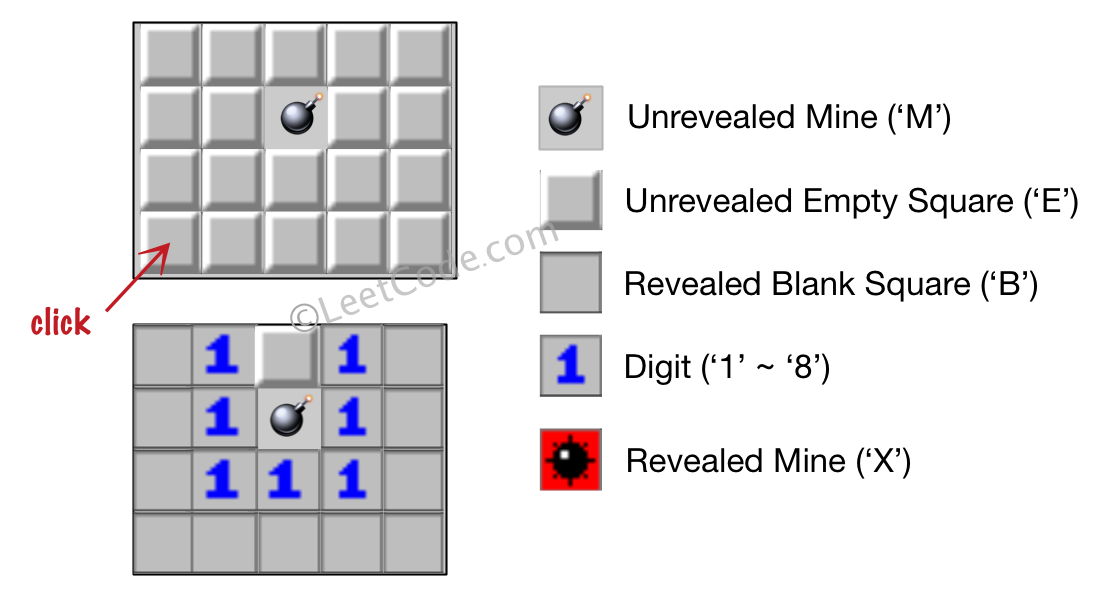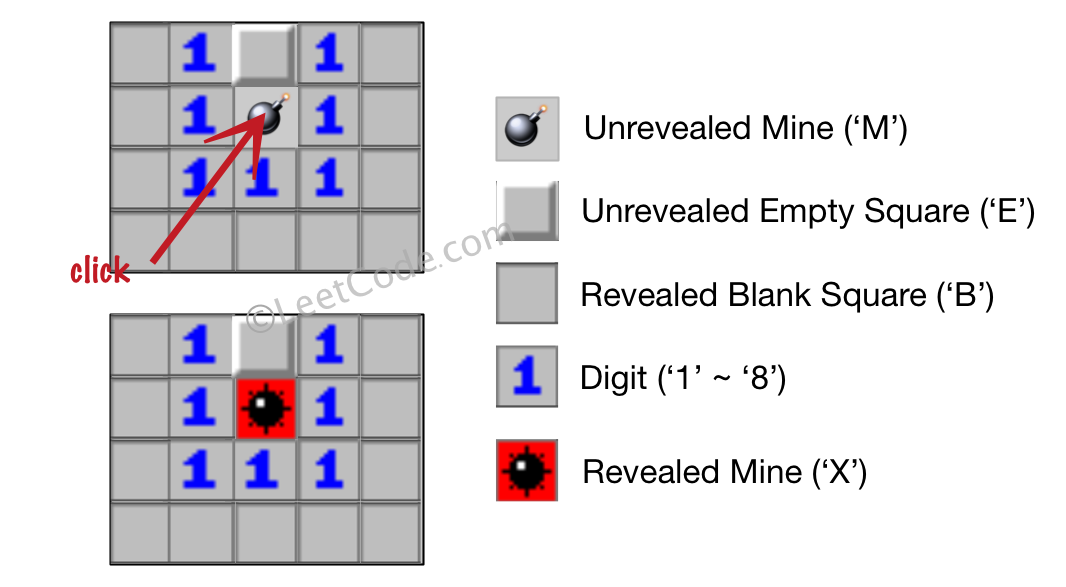https://leetcode.com/problems/minesweeper/discuss/99826/Java-Solution-DFS-+-BFS class Solution { private static final int[][] dirs = {{0, 1}, {0, -1}, {1, 0}, {-1, 0}, {1, 1}, {1, -1}, {-1, 1}, {-1, -1}}; public char[][] updateBoard(char[][] board, int[] click) { int m = board.length; int n = board[0].length; int x = click[0]; int y = click[1]; // if click on the mine if(board[x][y] == ‘M‘){ board[x][y] = ‘X‘; return board; }else{ // empty, get number of mines, int count = 0; for(int[] dir : dirs){ int r = x + dir[0]; int c = y + dir[1]; if(r < 0 || c < 0 || r >= m || c >= n) continue; if(board[r][c] == ‘M‘) count++; } if(count > 0){ board[x][y] = (char)(‘0‘ + count); }else{ // continue on dfs board[x][y] = ‘B‘; for(int[] dir : dirs){ int r = x + dir[0]; int c = y + dir[1]; if(r < 0 || c < 0 || r >= m || c >= n) continue; if (board[r][c] == ‘E‘) updateBoard(board, new int[]{r, c}); } } } return board; } } This is a typical Search problem, either by using DFS or BFS. Search rules: If click on a mine (‘M‘), mark it as ‘X‘, stop further search. If click on an empty cell (‘E‘), depends on how many surrounding mine: 2.1 Has surrounding mine(s), mark it with number of surrounding mine(s), stop further search. 2.2 No surrounding mine, mark it as ‘B‘, continue search its 8 neighbors. DFS solution.
Let‘s play the minesweeper game (Wikipedia, online game)!
You are given a 2D char matrix representing the game board. ‘M‘ represents an unrevealed mine, ‘E‘ represents an unrevealed empty square, ‘B‘ represents a revealed blank square that has no adjacent (above, below, left, right, and all 4 diagonals) mines, digit (‘1‘ to ‘8‘) represents how many mines are adjacent to this revealed square, and finally ‘X‘ represents a revealed mine.
Now given the next click position (row and column indices) among all the unrevealed squares (‘M‘ or ‘E‘), return the board after revealing this position according to the following rules:
Example 1:
Input: [[‘E‘, ‘E‘, ‘E‘, ‘E‘, ‘E‘], [‘E‘, ‘E‘, ‘M‘, ‘E‘, ‘E‘], [‘E‘, ‘E‘, ‘E‘, ‘E‘, ‘E‘], [‘E‘, ‘E‘, ‘E‘, ‘E‘, ‘E‘]] Click : [3,0] Output: [[‘B‘, ‘1‘, ‘E‘, ‘1‘, ‘B‘], [‘B‘, ‘1‘, ‘M‘, ‘1‘, ‘B‘], [‘B‘, ‘1‘, ‘1‘, ‘1‘, ‘B‘], [‘B‘, ‘B‘, ‘B‘, ‘B‘, ‘B‘]] Explanation:

Example 2:
Input: [[‘B‘, ‘1‘, ‘E‘, ‘1‘, ‘B‘], [‘B‘, ‘1‘, ‘M‘, ‘1‘, ‘B‘], [‘B‘, ‘1‘, ‘1‘, ‘1‘, ‘B‘], [‘B‘, ‘B‘, ‘B‘, ‘B‘, ‘B‘]] Click : [1,2] Output: [[‘B‘, ‘1‘, ‘E‘, ‘1‘, ‘B‘], [‘B‘, ‘1‘, ‘X‘, ‘1‘, ‘B‘], [‘B‘, ‘1‘, ‘1‘, ‘1‘, ‘B‘], [‘B‘, ‘B‘, ‘B‘, ‘B‘, ‘B‘]] Explanation:

Note:
原文:https://www.cnblogs.com/tobeabetterpig/p/9929948.html